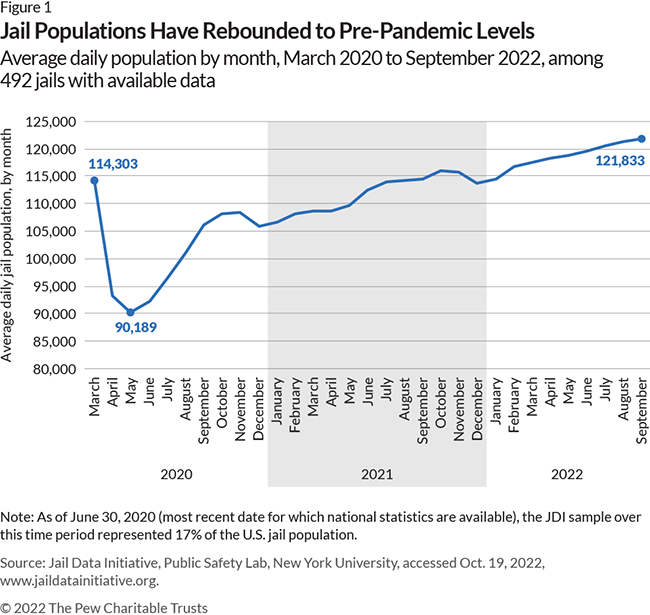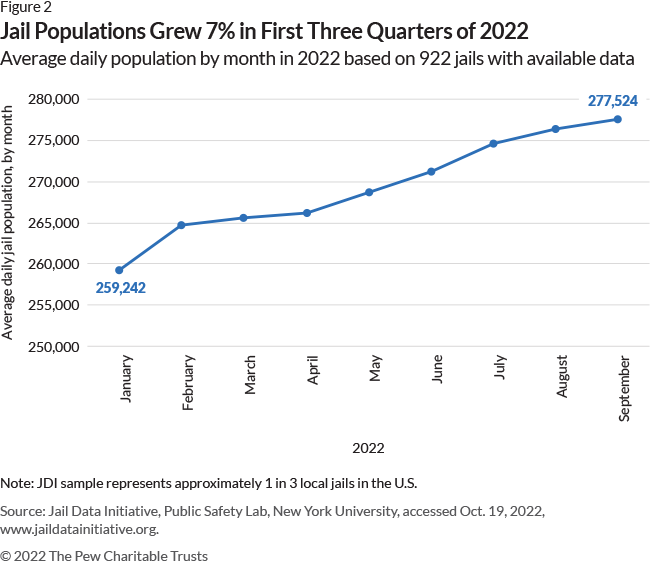Many Jails Are As Full As They Were Before COVID-19 Pandemic
As populations rise, localities can benefit from new data and policy resources

Jail populations dropped in the early months of the COVID-19 pandemic but have now rebounded in many facilities to levels seen in early 2020 or higher, according to figures from the Jail Data Initiative (JDI).
Researchers at JDI, a project of the Public Safety Lab at New York University, began collecting publicly available jail roster figures in 2019 and have been adding new data since for more jails. Local officials can use resources such as the JDI’s data dashboard to get a better sense of trends in their facilities and elsewhere to help analyze what is driving admissions and longer lengths of stay, and see how to better manage jail populations.
JDI collected data from March 1, 2020—just before widespread COVID-19 lockdowns—through Sept. 30, 2022, for nearly 500 jails. Together, they represent about 1 in 6 facilities across 40 states. Some notable trends emerge from this data. At the peak of COVID-19 precautions—between March 1 and May 1, 2020—the population in these jails fell by 26%, according to JDI. The federal Bureau of Justice Statistics reported a similar decline (25%) in all U.S. jails from July 2019 to June 2020. These reductions can be attributed to multiple factors, including a drop in arrests and bookings, as more people stayed home and local officials worked to reduce the number of people in their facilities to slow the spread of the virus.
However, as of Sept. 30, 2022, the populations in these jails had risen to somewhat higher levels as March 1, 2020. (See Figure 1.) Although the specific reasons for the increase are beyond the scope of the analysis, coronavirus-related safety measures that reduced jail populations have largely ended.
Much of that reversal had taken place by the end of 2020, but the population has continued to increase steadily, as seen in information from the larger number of jails with data available for all of 2022. In these 922 jails, the average daily jail population increased 7% from January to September 2022. (See Figure 2.)
Although these figures show overall trends across a significant share of U.S. jails—there are about 3,000 local correctional facilities nationwide—trends varied greatly by county.
Collecting and analyzing data on admissions and length of stay is the first step for local officials seeking to manage their jail populations. The JDI dashboard provides insights into trends in specific facilities across time; it also includes other metrics, such as length of stay, admissions versus releases, and the offenses for which individuals in jail were charged.
Jurisdictions can use the dashboard to generate individual jail profiles that can give a snapshot of who is in a county’s jail, for how long, and why, although the information that can be generated depends on what data is made publicly available online by the jail.
As Pew has noted earlier, as of 2017, jails cost taxpayers about $25 billion annually, excluding associated court and law enforcement expenses. Many factors contribute to rising or shrinking jail populations. For example, growing lengths of stay can mean that jail populations continue to rise even as admissions decline or remain stagnant. In looking at 751 jails with complete data available for the first nine months of 2022 compared with the same months in 2021, the number of people who had spent over a year in jail at the time of their release had tripled.
Jurisdictions that have collected data on their jail populations and are exploring policy solutions to reduce them can explore the County Guide for Reducing Jail Populations and Costs recently released by the National Association of Counties (NACo). The online toolkit was designed to help policymakers address factors that may be driving their local jail populations, including bookings and arrests, length of stay, technical violations of community supervision, and recidivism. The guide features national research as well as case studies from counties across the country that are improving their jail systems.
Used in tandem, the JDI dashboard and NACo’s guide offer county stakeholders important tools that can be used to examine reducing jail populations. Given both the costs associated with jails and the fact that even a short time in jail has negative consequences for those incarcerated, understanding what is driving local jail populations and taking steps to reduce them can benefit local communities.
Julie Wertheimer is director of The Pew Charitable Trusts’ public safety performance and mental health and justice partnerships projects, and Tracy Velázquez is a senior manager with Pew’s safety and justice projects.


America’s Overdose Crisis
Sign up for our five-email course explaining the overdose crisis in America, the state of treatment access, and ways to improve care
Sign up

5 Things to Know About Louisiana's Justice System


Rising Jail Stays Come at a Cost to Public Health, Local Budgets


Drug Arrests Stayed High Even as Imprisonment Fell














